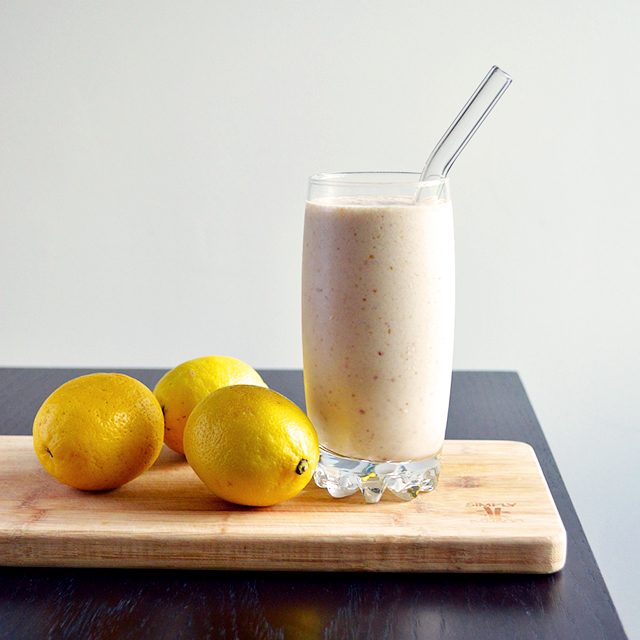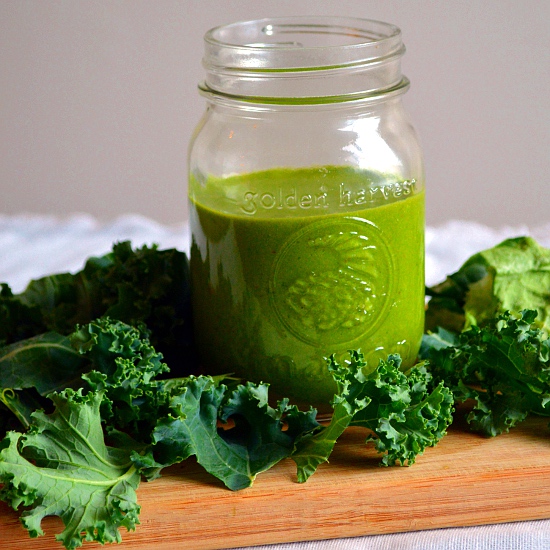Each month FBC member and nutritionist, Sondi Bruner, takes a favourite recipe and shows you how to adapt it to be allergen-friendly, as well as delicious and healthy. This month she’s got tips for dairy-free smoothies that are the full-meal deal.

Summer's almost over and I hope you're not sad.
I'm never bummed about the curtains closing on the summertime season. I was always a big nerd and loved the whole back-to-school vibe, and now as a grown-up I love fall because it involves the best food: butternut squash, pumpkin, apples, pears, cinnamon, onions, garlic, Brussels sprouts, hearty soups and stews, steaming hot chocolate, and baked dairy-free mac and cheese.
Are you getting excited yet?
Of course, as summertime ends we begin to turn our attention to schedules and habits and plans. For those of us who have spent the summer indulging in too many cocktails or burgers or ice cream sandwiches, the fall is an ideal time to get our health back on track.
And there is no better way to do that than a healthy, allergen-friendly smoothie.
A typical smoothie recipe contains:
- Fruit
- Yogurt
- Milk
Most of us are probably accustomed to drinking smoothies that contain only fruit and dairy, but in today's post I'm going to share with you how to make dairy-free smoothies that can also function as complete, satiating meals.
Replace the Dairy

There are so many options to replace dairy products in smoothies. My all-time favourite is coconut milk, but almond milk, oat milk, rice milk, cashew milk and sesame milk are all good options, too. Another neat trick is to freeze some of your non-dairy milk in ice cube trays, which will add that cold thickness to smoothies that we all love.
For a yogurt substitute, as with non-dairy milk, there are a multitude of dairy-free alternatives. Plain coconut yogurt and almond yogurt are my top choices (just read labels carefully and check that your brand doesn't contain any glutenous flours as a thickener, or carrageenan, which is linked to intestinal inflammation). You can also try a hand at making your own if you have the fermentation skillz. But to be completely honest, I don't personally add yogurt to my smoothie very often, as I can create a thick consistency using other elements like frozen fruit, ice, avocado or almond milk cubes.
Throw in some greens
Drink your salad by adding in a few handfuls of greens to your smoothie. This provides a load of extra fibre, vitamins and minerals, and allows you to sneak in an additional serving of veggies (especially to salad-averse kiddos).
If you've never had a green smoothie before, start off with a mild green such as spinach or romaine lettuce. You won't be able to taste them at all. Then, after some green smoothie practice, you can add strong-flavoured greens like kale, arugula, watercress or chard.
Depending on the combination of greens and fruit you use, the colour of your smoothie can end up anywhere from bright, vibrant green to dark purple to light greenish-grey. No matter how weird it looks, it will still taste good!
Choose your fruit carefully
Copious amounts of ultra-sweet fruits can lead to blood sugar spikes (particularly if you don't include enough protein and fat, which we'll get to shortly). Many of us load up our smoothies with frozen bananas, mango, pineapple, watermelon, grapes and dates for sweetness, especially when trying to offset the flavour of greens.
I recommend primarily using low-glycemic fruits that are also high in fibre such as berries, pears, lemons, limes and avocado (yes, avocado is a fruit), and then enhance your smoothie with a small amount of sweeter fruits.
Add a protein source
In order to make a smoothie a satisfying meal, you need sufficient amounts of protein and fat. Nuts and seeds, or their butters, fill this role perfectly. I usually add at least two tablespoons of seeds to my smoothies (hemp, chia, and sesame are my besties), or at least two tablespoons of nut butter or tahini.
Include healthy fats

The combination of complex carbohydrates, protein and fat will help you sustain your energy levels and feel satiated throughout the morning. Dairy-free milk like coconut milk, which is packed with easy-to-digest, energy-boosting fats, is a good option, as are nuts and seeds (isn't it awesome when our ingredients do double duty?).
Avocado has become a smoothie staple for me, as it not only supplies good fats, fibre, vitamins and minerals, but also gives smoothies a milkshake-esque, creamy texture. You can also try coconut oil, avocado oil, walnut oil, almond oil, or flax oil.
Try gluten-free grains
Grains in a smoothie? Yep, they work. Pick a grain that's easy to blend, such as oats, buckwheat or quinoa (you can also soak gluten-free grains overnight so they'll blend effortlessly, or use pre-cooked grains), and start off with one to two tablespoons. They'll offer additional texture as well as flavour.
Don't forget about vegetables, herbs and spices
Veggies other than greens make great additions to smoothies. Celery, cucumber, carrots, beets, fennel, zucchini, winter squash and even cauliflower can be tossed into the blender, as can herbs like mint, basil or rosemary, roots such as ginger or turmeric, or spices such as cinnamon, cardamom, or nutmeg. Play around and see what combinations you love!
And, if you're feeling adventurous, you can even try adding cooked beans such as lentils into your smoothies. We're getting wild here, folks.
- 1 cup spinach leaves (or romaine, butter lettuce, kale, arugula, etc.)
- ¾ cup fresh or frozen blueberries
- ½ - ¾ cup water or non-dairy milk
- ½ an avocado
- 2 tbsp hemp seeds
- 1 tbsp cacao powder, or 1 tsp cocoa powder
- Optional add-ins: nut butter, coconut oil, coconut butter, protein powder, sweetener to taste
- Add all ingredients to a blender and blend until smooth. Taste. If the smoothie isn't sweet enough, blend in some maple syrup, raw honey, or a Medjool date.
More Reading
Check out more of Sondi’s Allergen-Friendly Remixes for great ideas on revamping your favourite recipes to make them allergen friendly! Here are a few to check out:
- How To Make Creamy Non-Dairy Pasta Sauces
- Allergen Friendly Recipe Remix: The Granola Bar
- Creating Hearty, Filling Allergen Friendly Salads For Fall
Got a favourite recipe you’d like to see get an Allergen-Friendly Makeover? Let us know in the comments...
Sondi Bruner is a holistic nutritionist, freelance writer and food blogger. She educates people who follow allergen-friendly diets about how to eat simply, deliciously and safely, allowing them to rediscover the pleasure of food. When she’s wearing her writer’s hat, she works with natural health brands to create content that will help their customers live fulfilling, healthful lives. Find out more at www.sondibruner.com. Or you can follow Sondi on Facebook or Twitter.








Leave a Reply